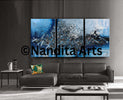
A Quick Tour to the Origin of Abstract Art Paintings
, by Nandita Albright, 2 min reading time

, by Nandita Albright, 2 min reading time
When people talk about art in general, they could be talking about any art style. It could be contemporary, post-impressionism, abstract, minimalism, romanticism, neoclassicism, or any other art style. While each of them has its peculiar characteristics and lauded for the same, perhaps the most interesting art style is abstract art because it leaves viewers with a wider scope of imagination with an element of mystery.
Also called non-objective art or non-representational art, abstract art paintings are the ones in which the portrayal of things from the visible world doesn’t have much significance as all of the elements – forms, color, lines, tones, and textures are in abstract form.

Today, we will talk about the origin of abstract art paintings to learn more about this art style.
Origin of Abstract Art Paintings
The history of abstract art dates back to the 19th century. This is the period that was mostly characterized by elaborated representational art. However, this period also produced painters who examined the mechanism of light and visual perception. Romanticism further introduced ideas about a style of art that didn’t emphasize on imitation and idealization. Instead, it stressed the role of deeper imagination and the unconscious element as the essential creative factors.
Later, several painters began to accept this freedom of art and responsibilities emerged by the coalescence of creative elements.
There is a deep distinction between abstracting ideas from appearances to the point of anonymity and making art out of forms that are not drawn from the visible world. Around four or five years before the First World War, artists such as Robert Delaunay, Wassily Kandinsky, and Vladimir Tatlin transitioned to fundamental abstract art. In fact, Kandinsky is considered as the first modern artist to provide pure abstract art paintings with no recognizable objects in 1910-11.
The rise of the De Stijl group in the Netherlands and Dada group in Zurich expanded the spectrum of abstract further. Abstract art wasn’t as popular during the first and second world wars. But after the Second World War, an American school of abstract painting was established called Abstract Expressionism and then, this art style began to be widely accepted within European and American paintings.
Abstract Art Movement
Gradually, abstract art began so much popular that it gave rise to the abstract art movement in the United States. The movement is also, sometimes, called Abstract Expressionism because, even though this art style has no subject, it still conveys some kind of emotion.
The Abstract Expressionism movement started in the 1940s in New York City after the Second World War. However, the first real abstract art was painted by some expressionists in the early 1900s.
Even though this art has puzzled and confused a huge number of people, it is greatly appreciated by those who have accepted its non-referential language and know its value.
Are you also an abstract art lover? If so, don’t hesitate, order abstract art paintings online available for sale right away, and show your true love for this unique and amazing art style.

Subscribe to our emails